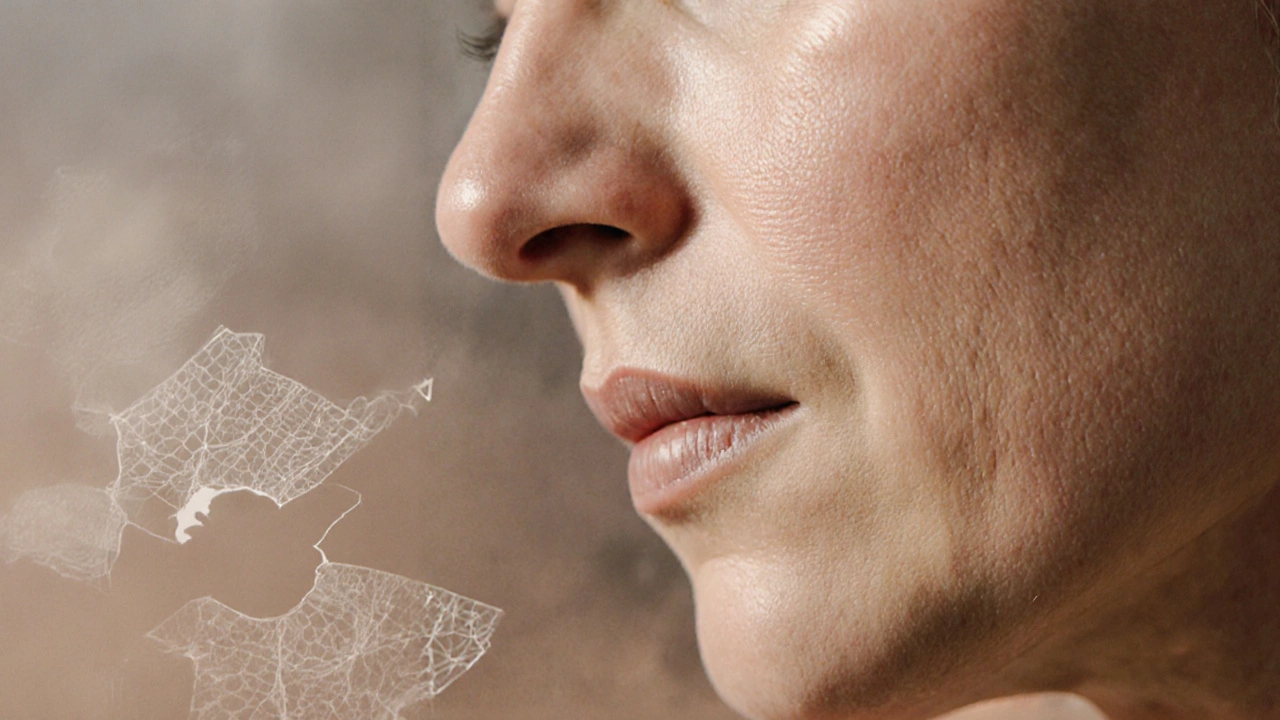Vitamin Deficiency Symptom Checker
Check Your Vitamin Deficiency Risk
Identify which vitamin deficiency might be causing your sagging skin and other symptoms. Select all symptoms you're experiencing to see which vitamin is most likely missing.
Your Symptoms
Select all symptoms you're experiencing
Your Likely Deficiency
Deficiency Detected
Based on your symptoms, you may be experiencing vitamin C deficiency, which is directly linked to collagen breakdown and sagging skin.
What You Should Do
Increase your vitamin C intake with foods like oranges (70mg), strawberries (89mg), or red bell peppers (95mg). Most adults need 90mg (women) to 110mg (men) daily.
Tip: Your skin may show improvement within 4-6 weeks of consistent intake as new collagen builds.
When your skin starts to droop, you might blame gravity, age, or a heavy moisturizer. But sometimes the real cause is something you’re not eating enough of. Certain vitamin gaps can weaken the skin’s structural proteins, making it look loose and tired.
The link between vitamins and skin firmness
Skin isn’t just a blanket of cells; it’s a living tissue supported by a network of proteins, fats, and water. Collagen the main structural protein that gives skin its strength and bounce acts like the scaffolding of a building. When collagen production drops, the scaffolding sags, and the skin follows. Vitamins act as the foremen that keep collagen factories running smoothly.
Each vitamin either directly participates in the synthesis of collagen or protects existing collagen from oxidative damage. Without the right nutrients, the skin’s elasticity-its ability to stretch and snap back-diminishes, leading to the familiar “sagging” look.
Vitamin C a water‑soluble vitamin crucial for collagen synthesis and skin health - the primary culprit
Among all the nutrients, vitamin C deficiency is the one most directly tied to sagging skin. Here’s why:
- Collagen synthesis: Vitamin C is a co‑factor for the enzymes prolyl‑ and lysyl‑hydroxylase, which stabilize the collagen triple‑helix. Without enough Vitamin C, the body can’t efficiently build strong collagen fibers.
- Antioxidant shield: The skin faces constant oxidative stress from UV rays, pollution, and metabolic by‑products. Vitamin C neutralises free radicals, preventing them from breaking down collagen already in place.
- Skin repair: In the wound‑healing phase, Vitamin C speeds up the formation of new tissue, keeping the skin taut.
If your diet lacks Citrus fruits, strawberries, kiwi, or bell peppers, you may be walking a nutritional tightrope that compromises collagen. Clinical observations of scurvy-classic severe Vitamin C deficiency-include bruising, bleeding gums, and markedly loose skin.
Other vitamins that affect skin elasticity
While Vitamin C gets most of the spotlight, a few other vitamins play supporting roles. Deficiencies in them can also contribute to a lax appearance.
- Vitamin E a fat‑soluble antioxidant that protects cell membranes - low levels reduce the skin’s ability to fend off oxidative damage, accelerating collagen breakdown.
- Vitamin A retinoids that regulate cell turnover and support dermal matrix production - deficiency can lead to dry, rough skin and weaker connective tissue.
- Vitamin D a hormone‑like vitamin that influences skin barrier function - insufficient Vitamin D is linked with slower wound healing and reduced skin elasticity.
- Niacin (Vitamin B3) supports skin barrier integrity and reduces inflammation - severe deficiency (pellagra) presents with dermatitis that can feel flaky and less firm.
Each of these nutrients works hand‑in‑hand with Vitamin C, creating a nutritional ecosystem that keeps skin plump and resilient.

Spotting a deficiency beyond sagging skin
When a vitamin shortage is the root cause, sagging skin is usually just one symptom among many. Knowing the full picture helps you pinpoint the missing nutrient.
| Vitamin | Primary Skin‑Related Symptoms | Other Body Signs |
|---|---|---|
| Vitamin C | Sagging, bruising easily, slow wound healing | Bleeding gums, joint pain, fatigue |
| Vitamin E | Dryness, increased fine lines | Muscle weakness, impaired immune response |
| Vitamin A | Rough texture, hyperkeratinisation | Night blindness, respiratory infections |
| Vitamin D | Loose skin, delayed healing | Bone pain, frequent infections |
| Niacin (B3) | Flaky rash, loss of elasticity | Diarrhoea, memory issues |
When you notice a cluster of these clues, it’s worth checking your diet or having a blood test.
Fixing the gap: diet, foods, and supplements
Restoring the right vitamin levels is usually straightforward-if you know where to look.
- Vitamin C: One orange (70mg), a cup of strawberries (89mg), or a half‑cup of red bell pepper (95mg) meets most adult daily recommendations (90mg for women, 110mg for men).
- Vitamin E: A handful of almonds (7.3mg), sunflower seeds (5mg), or a tablespoon of wheat germ oil (20mg).
- Vitamin A: Sweet potato (961µg RAE), carrots (835µg), or liver (up to 6,000µg).
- Vitamin D: Fatty fish (salmon 10µg per 100g), fortified dairy, or a 15‑minute midday sun exposure (10‑30µg depending on skin tone).
- Niacin: Chicken breast (13mg per 100g), tuna (10mg), or mushrooms (3mg).
If food alone feels insufficient, a well‑formulated multivitamin or targeted supplement can bridge the gap. Look for “bioavailable” forms-ascorbic acid or magnesium ascorbate for Vitamin C, mixed tocopherols for Vitamin E, and methylcobalamin‑free Vitamin B3 if you’re sensitive.
Remember: excessive Vitamin A can be toxic, especially in supplement form, so stay within the recommended 700‑900µg RAE for adults.

Practical daily checklist for skin‑supporting nutrition
- Start the day with a Vitamin C‑rich smoothie (orange, kiwi, spinach).
- Snack on a handful of nuts or seeds for Vitamin E.
- Include a colour‑rich side (sweet potato, carrots, bell peppers) at lunch.
- Choose fatty fish or fortified plant‑milk for Vitamin D at dinner.
- Incorporate protein sources like chicken or tofu that also supply Niacin.
- If you live north of the Thames and get less than 15minutes of sun a week, consider a 1,000IU Vitamin D supplement.
- Take a broad‑spectrum antioxidant supplement only if blood tests show a shortfall.
Stick to this routine for a few weeks, then reassess how your skin feels. Most people notice tighter texture within 4‑6weeks of correcting a deficiency.
Frequently Asked Questions
Can a single vitamin fix sagging skin?
Vitamin C is the most influential because it directly drives collagen production. However, optimal skin firmness requires a balanced mix of vitamins, minerals, and protein.
How long does it take to see results after raising Vitamin C intake?
Most people notice an improvement in skin texture and elasticity after 4‑6 weeks of consistent Vitamin C consumption, because new collagen takes time to mature.
Is topical Vitamin C as effective as eating it?
Topical serums can protect the surface from oxidative damage, but they don’t reach the deeper fibroblasts that build collagen. For lasting firmness, oral intake is essential.
Can I take a megadose of Vitamin C to speed up skin tightening?
Higher doses (>2g per day) are mostly excreted and can cause digestive upset. Stick to the recommended 90‑110mg daily unless a doctor advises otherwise.
What other lifestyle factors worsen skin sagging?
Chronic sun exposure, smoking, poor sleep, and high‑sugar diets accelerate collagen breakdown. Pair nutritional fixes with sun protection, quitting tobacco, and regular exercise.
Addressing vitamin gaps isn’t a miracle cure, but it’s a science‑backed way to give your skin the building blocks it needs to stay firm. Start with the foods, check your levels if you’re unsure, and watch the sagging give way to a smoother, more youthful contour.

